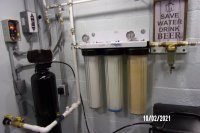CenterTree
Member
Finally got my system up and running (sort of). I have a 240' low yield well (1.5GPM) feeding into a holding tank in the basement via a cycle sensor and controlled shutoff via float switch.
All seems OK with the Cycle Sensor section on the well feed, as far as I can tell.
Float switch works good.
The setup is 50/70 PSI. 10 gal SideKick.

Problem I am having is that I get the submersible pump (inside the holding tank) to run using the "L" lever on the pressure switch. The pump will run about 1 minute pressurizing the PsideKick to 70PSI and the pressure gauge up stream of the cycle stop will set at 96 PSI while pump is running. All seems good. Pressure will then hold at 70 indefinitely. (both gauges).
I can run water and leave a faucet open forever and the subPump will stay on at 62PSI indefinitely. This is per design with the Cycle Stop Valve. The PROBLEM is if I stop using water, the pressure will drop slowly with each successive use of water until the pressure tank gauge reaches about 55PSI and then, like voodoo, the gauge drops to ZERO quickly.
Of course then their is no water available until I reset the pressure switch "L" lever and start over.
Please tell me someone has a "simple" solution. I've spent weeks on this system and we are soooooo close to having REAL water in out house. Any ideas?
I thought the pressure tank/gauge would stop at 50 then the subPump would restart the cycle.
( tank air PSI measured at 55.6 PSI) No leaks.
Don't laugh at my tilted gauge on the vertical pipe. That is just where it ending up landing when I tightened it to it's max.



All seems OK with the Cycle Sensor section on the well feed, as far as I can tell.
Float switch works good.
The setup is 50/70 PSI. 10 gal SideKick.
Problem I am having is that I get the submersible pump (inside the holding tank) to run using the "L" lever on the pressure switch. The pump will run about 1 minute pressurizing the PsideKick to 70PSI and the pressure gauge up stream of the cycle stop will set at 96 PSI while pump is running. All seems good. Pressure will then hold at 70 indefinitely. (both gauges).
I can run water and leave a faucet open forever and the subPump will stay on at 62PSI indefinitely. This is per design with the Cycle Stop Valve. The PROBLEM is if I stop using water, the pressure will drop slowly with each successive use of water until the pressure tank gauge reaches about 55PSI and then, like voodoo, the gauge drops to ZERO quickly.
Of course then their is no water available until I reset the pressure switch "L" lever and start over.
Please tell me someone has a "simple" solution. I've spent weeks on this system and we are soooooo close to having REAL water in out house. Any ideas?
I thought the pressure tank/gauge would stop at 50 then the subPump would restart the cycle.
( tank air PSI measured at 55.6 PSI) No leaks.
Don't laugh at my tilted gauge on the vertical pipe. That is just where it ending up landing when I tightened it to it's max.

